The Close Circuit Television (CCTV) security system which saw the installation of more than one hundred cameras in and around the city continues to function and has led to the arrest and prosecution of “lots” of traffic and crime offenders to date.
“It is functioning. We put it up there for offences being committed so that we can have what is called a video recording of what is taking place in our city,” de facto Minister of Public Security Khemraj Ramjattan recently told Stabroek News.
Ramjattan said since the establishment of the system, “lots” of persons who were found in breach of the law have been arrested and charged with the aid of video recordings obtained from the cameras.
“Those who breach it and they are clear on the cameras, they are charged. Lots of traffic offenders have been charged as a result of the cameras and a lots of arrests have been made as a result of the cameras,” he said.
The public has not been provided with specific information on who is monitoring the feed, what exactly they are looking for, the charges that have been brought and whether the video feed is used as actual evidence. It is also unclear whether the cameras have performed to expectation.
In July last year, the government had unveiled the Huawei-built Safe City Command Centre for the CCTV Surveillance system.
The Safe City system is made up of 102 Intelligent Video Surveillance sites, each consisting of three to four cameras, the command centre, which will have the capacity for about 25 agents, two systems that can be mounted on vehicles, as well as three different types of radios and body cameras.
Several months after, an additional 17 cameras were installed across the country at crucial locations such as the Stabroek Market, the Berbice River Bridge and the Lusignan prison.
This bought the total number of cameras installed to 119.
The cameras are equipped with several features, such as video monitoring systems that aid in the deployment and tracking of law enforcement officers, remote tracking, a facial tracking system, a real time facial recognition and a licence plate location history search system.
The system is operational 24-hours per day and monitors sections of Georgetown and the East Bank of Demerara. Among some of the areas are Avenue of the Republic, Water Street, Lombard Street, Brickdam, Lime Street and Croal Street.
The system, which is a component of the US$36 million National Broad-band Expansion Project (NBEP), is expected to be expanded across the country.
The installation of the cameras has raised a number of privacy concerns, particularly since it includes the use of face recognition and tracking technology.
Ramjattan said that intelligence obtained via the system is not being “used against” any citizen. “If you feel we are doing some intelligence to use against you, no we are not going to do that,” he said.
Chairman of the Private Sector Commission (PSC) Gerry Gouveia has welcomed the initiative.
“As a citizen, it gives me a good sense of confidence….. It a good thing for crime, even traffic accidents. If something should happen there is record,” Gouveia said.
Gouveia noted that the cameras should not pose a threat to anyone unless they have something to hide. “If you have nothing to hide those cameras are a good sense of security,” he noted.
At the launch last year, Ramjattan described the initiative as one of the best developments for the country as it is also expected to enhance the capabilities of law enforcement officials. “This is exactly what Guyana needs…this is just going to be one of the best developments for our country in relation to security and to see the capacities and the capabilities being built in to ensure that we can literally track vehicles, track suspects to the extent to knowing where they are and what time they would have been there through this technology, I am just so thrilled,” Ramjattan said.
Minister of Public Telecommunications Catherine Hughes also spoke at the launch and said that the aim of the initiative was to ensure that citizens are provided with “prompt public security services.” “Today, what we are really showing you is how through technology we are able to guarantee a higher level of service to citizens in Guyana,” she noted.






